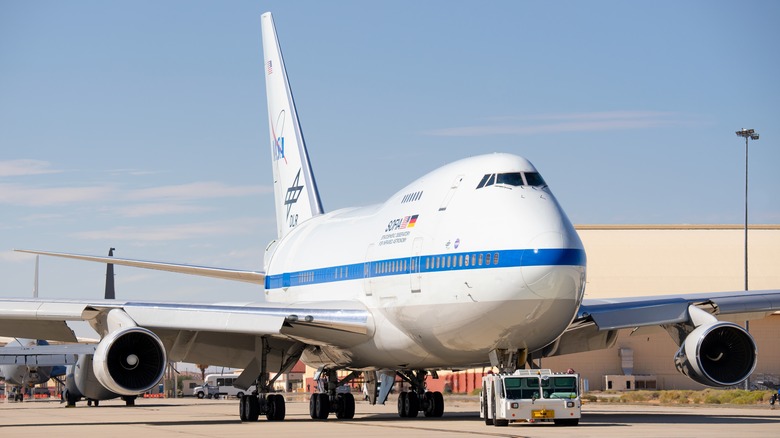What Is The Boeing 747SP, The Short And Stubby Wide-Body Jet?
Before the Boeing 747 was discontinued in 2023, it built a number of variants for the aircraft to suit a variety of needs. One such derivative was the 747SP (Special Performance).
This version of the wide-body jumbo jet entered commercial service in 1976 after Pan American World Airways and Iran Air both requested a variant that could fly non-stop trans-Atlantic routes, from New York to the Middle East. At the time, Iran Air's Tehran to New York route was the longest in the world (roughly 6,124 miles), proving difficult for the 747-100 to accomplish without refueling, as it had a maximum range of 5,620 miles. So Boeing created the 747SP.
In addition to Pan Am and Iran Air, Korean Air, Qantas, Trans World Airlines, and South African Airways ordered this variant from Boeing. Many airlines favored its ability to land on short runways. A total of 44 747SPs were built by 1982 when Boeing put a stop to production, with 10 of them going to Pan Am. The United Arab Emirates government placed an order and Boeing briefly restarted the production line in 1987.
However, having a longer range than other variants at the time isn't the only feature that sets this aircraft apart from its siblings. It also seats fewer passengers and has a different exterior geometry.
The specs for Boeing's 747SP
Boeing's 747SP is the runt of the litter, sitting at 184 feet, 9 inches long compared to the 747-100 (and the modernized 747-400), which was 231 feet, 10 inches long. It could also only seat 313 to 400 passengers, significantly less than other variants that can seat between 440 and 660. With a range of 7,650 miles and a capacity for 50,360 gallons of fuel, it could get across the Atlantic Ocean with plenty of fuel to spare to get beyond Tehran if needed. Its four Pratt & Whitney JT9D-7R4W or Rolls-Royce RB211-524C2 turbofan engines gave it the 747SP a cruising speed of Mach 0.88, but it could fly as fast as Mach 0.92 with 46,500 pounds of force.
Boeing added 5 feet to its vertical tail and modified the flaps to a single variable pivot flap. However, the 747SP kept all the same electronic systems as its siblings. All of these capabilities allowed the plane to break a few world records. A United Airlines 747SP set a round-the-world record in 1988, traveling around the globe in 36 hours, 54 minutes, and 15 seconds. Before that in 1976, Pan Am's "Clipper Liberty Bell" circumnavigated the globe in 39 hours, 25 minutes, and 53 seconds. But the Special Performance variant didn't stay in production nearly as long as other 747s, nor did it come anywhere near the 200 completed units Boeing aimed for.
What happened to the 747SP?
By 1987, Boeing had built and delivered a grand total of 45 747SPs. Over time as several airlines (looking at you, Pan Am and TWA) went out of business, the 747s found other homes or were scrapped. The first 747SP to meet the scrapyard was in December 1997. By 2007, there were a mere 17 of them in operation.
As of 2022, there were a total of four 747SPs still in service. The famous engine maker Pratt & Whitney operated two of them as a testing platform, NASA used one for its Stratospheric Observatory for Infrared Astronomy project, and the Las Vegas Sands resort had one in its luxury fleet. Celebrities like Kim Kardashian and Kanye West have used the resort's 747SPs. The Sands used be the proud owner of two of the 747s that it got from Pan Am and TWA, but heavy winds from Hurricane Laura ripped through a hangar in Louisiana in 2020 and damaged one of the planes beyond repair. The other was retired this year.
Boeing was already hard at work developing the 747-400 when it produced one more Special Performance version for The United Arab Emirates in 1987. The first 747-400 took flight in 1988. The 747-400 could fly a distance of 8,383 miles and hold more passengers — perhaps why Iron Maiden leased one – outperforming the 747SP. Additionally, rising fuel costs made it an expensive airplane for airlines to maintain, making newer models more economical to run.


